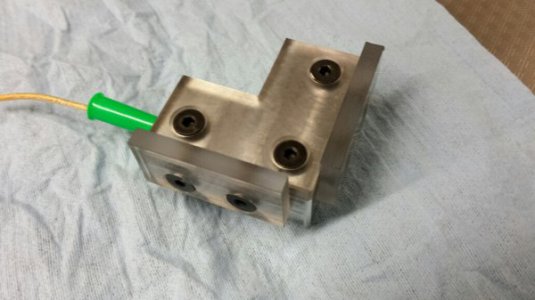- Joined
- Feb 1, 2015
- Messages
- 9,993
Take a look at the Tormach TTS system. You don't need the ATC to gain the benefits of the TTS system. The TTS system can be adapted to any mill with R8 tooling. The principle is that the ER20 collet chuck is mounted in a 3/4 R8 collet and as the R8 collet is tightened, it pulls the ER20 collet chuck tight to the spindle face, ensuring a reproducible tool offset. This allows the chuck with tool to be removed and remounted without losing accuracy.The ER collet chucks can be purchased for as little as $25 and other options such as TTS Jacobs taper adapters or end mill holder for Weldon shanks are available. ER32 and ER16 collet chucks are available as wellNow that I have my CNC G0704 running, I've been thinking of ways to make living with it easier and do things faster. I thought I'd put out a couple of ideas running in my head and ask you gurus what you think.
I'm not doing this for money, but a lot of time spent indicating the edges of a part for every part just seems like a waste of time. It's not hard, it's just tedious. Industry uses tooling plates or homing switches that always are (0,0) and I'm thinking of doing something like that. I've assigned a fixture (0,0) for several parts on a little project I'm building, making the front left hand corner of the fixed jaw on my vise into (0,0). All I have to do is put a piece in the vise, press it against the stop and it's ready to machine. Yeah, all my Y numbers are negative, but no big deal.
The issue is that the vise only holds a small range of sizes without changes. Something like this Sherline-sized tooling plate from eBay looks like the trick to do (no relation to the seller, don't know if it's any good, and all disclaimers). Set one corner as the reference point and go from there. Making or getting one for the G0704 might be a good exercise, although I think the clamping screw holes would have to be bigger due to the (much) higher power of the Grizzly over the Sherline.
Do any of you guys do anything like this?
The other thing I'm trying to improve is tool changing. I'd love a Tormach changer and the whole TTS, but they're like $4000 so that ain't happening (I am a retiree, after all). So I was thinking of getting a bunch of R8 end mill holders at $16 or $17, like this from LMS, and making a system of my own. Set the tools to all the same distance out of the holder (1" as example), and then when it's time to change tools, I'll still need to swap tools in the spindle, but they'll all be zeroed once the new end mill holder is in the spindle. I can replace the four sided nut on the G0704 with a regular hex head and stick a socket on a battery powered wrench to speed loosening/tightening. Or maybe a manual drawbar like Hoss shows on the DVD.
Again, anybody done anything like this?
Bob
You still have to manually load the tooling but it removes the necessity of re-referencing your tooling each time you mount it. I use the Tormach system in both my Tormach 770 and my old mill drill. I believe that Tormach has a white paper describing the process for converting a mill to the TTS system. It basically requires checking your spindle face for runout and truing if necessary. Tormach sells a special R8 collet for use with the TTS system but you can make your own easily by grinding the face of a 3/4" R* collet for clearance.

